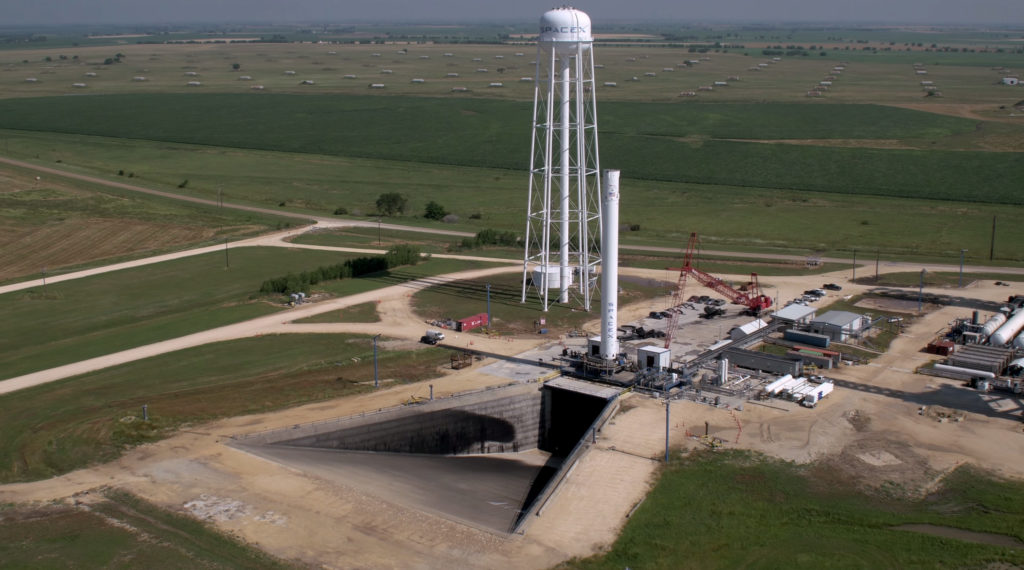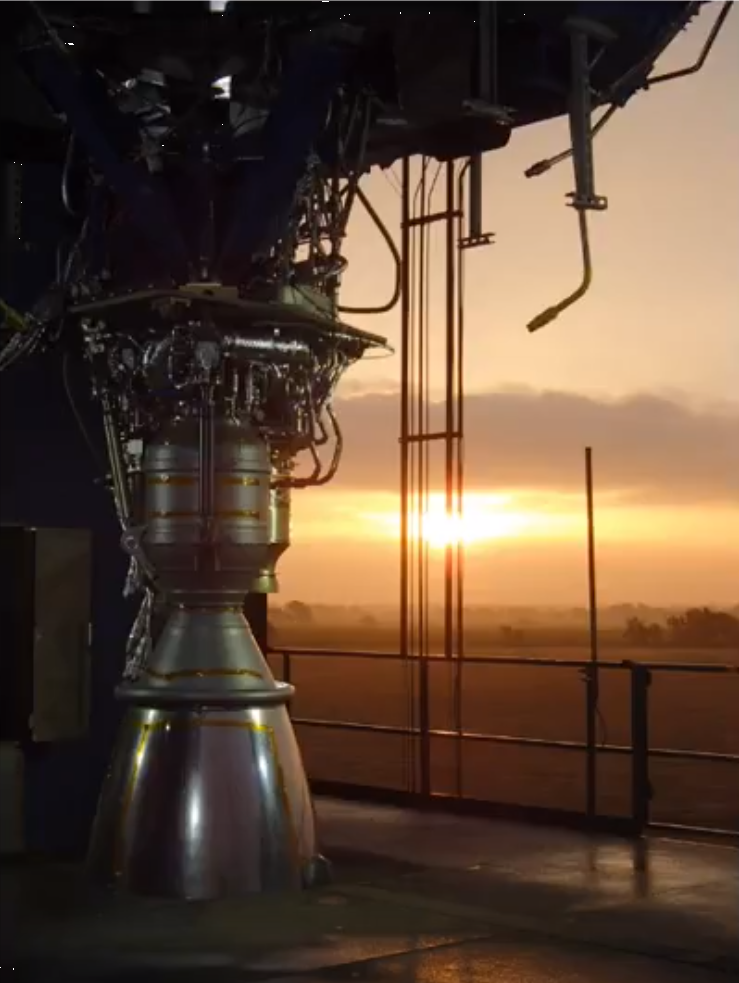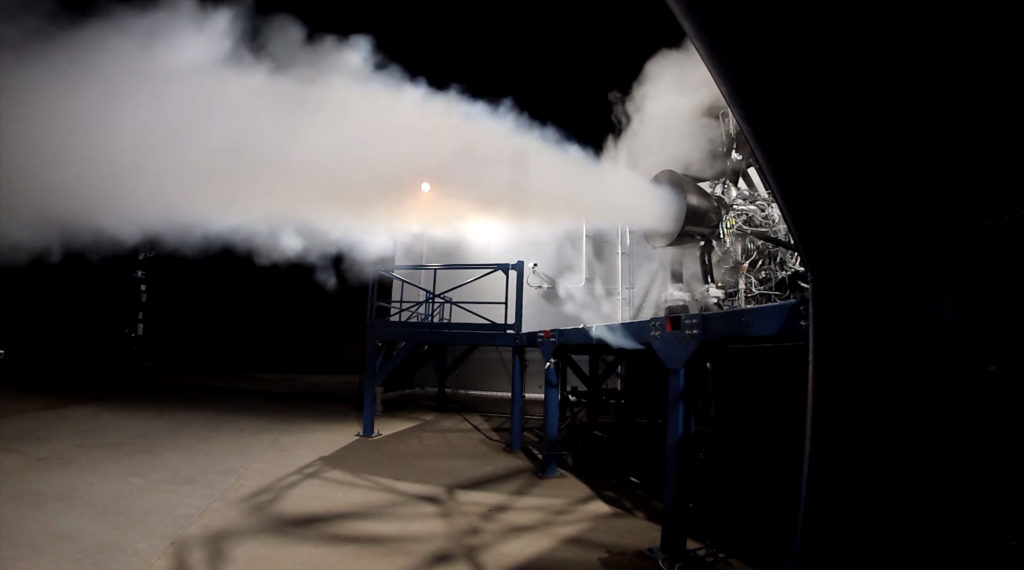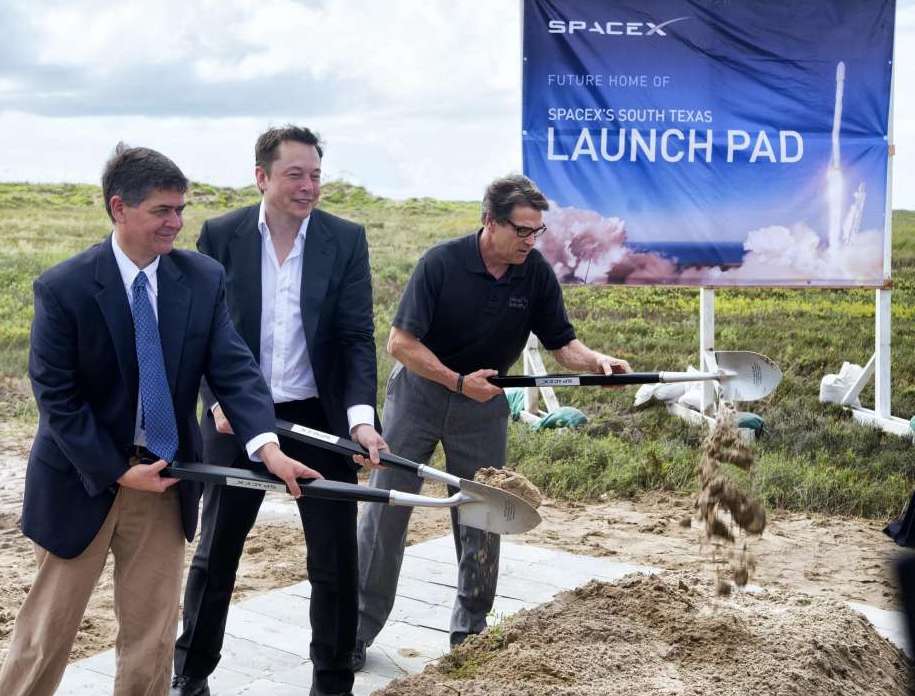
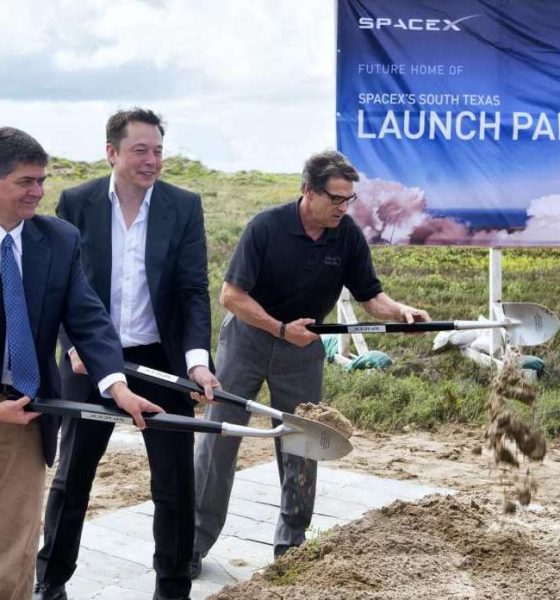
News
SpaceX confirms plan to activate South Texas launch site in late 2018
Following our report that Elon Musk’s space company was progressing on the development of a new launch site in Texas, SpaceX’s Senior Communications Manager James Gleeson has confirmed with Teslarati that the company is, in fact, working towards the activation of its South Texas launch facilities in late 2018, possibly sooner.
“We are currently targeting late 2018 for the site in South Texas to be operational but we’re reviewing our progress and will turn the site online as soon as it’s ready.”
Combined with a comment made in early January by SpaceX President Gwynne Shotwell, BFS development by all appearances is going quite smoothly. Still, it’s likely that the Boca Chica site’s late 2018 “operational” status refers mainly to an ability to support something less than orbital launches, perhaps suborbital testing of BFS. According to a source knowledgeable with SpaceX’s South Texas outlook, there are currently no plans to manufacture BFR in the region, although the company has enjoyed the warm welcomes it’s received from local leaders enthusiastic about the company’s local expansion.
- SpaceX already operates an extensive rocket testing facility in Central Texas, tests that previously included flights of a Falcon 9 reuse demonstrator. (SpaceX)
- The majority of testing done at McGregor is of individual Merlin engines, each of which is fired for around dozens of seconds to verify performance and quality. (SpaceX)
- SpaceX’s current Texas facilities feature a test stand for Raptor, the engine intended to power BFR and BFS to Mars. (SpaceX)
The question of where to test the first Big F____ Spaceship (BFS) prototype also appears to be undecided at the moment, and comments made by CEO Elon Musk immediately after Falcon Heavy’s inaugural launch further confirmed that a couple of different options are under consideration, one of which involves using Boca Chica as a testing facility for the Mars rocket. True orbital launch operations are thus highly unlikely to begin at Boca Chica any earlier than mid-to-late 2019, and that aspirational timeline is of course intimately dependent upon the relatively smooth development and testing of BFS, as well as the potential value SpaceX might see in a fully-private orbital launch complex compatible with their proven Falcon family of rockets. A site wholly dedicated to Starlink launches, for example, could rapidly speed up the internet satellite constellation’s deployment, the completion of which could be a massive source of income capable of funding the company’s interplanetary ambitions.
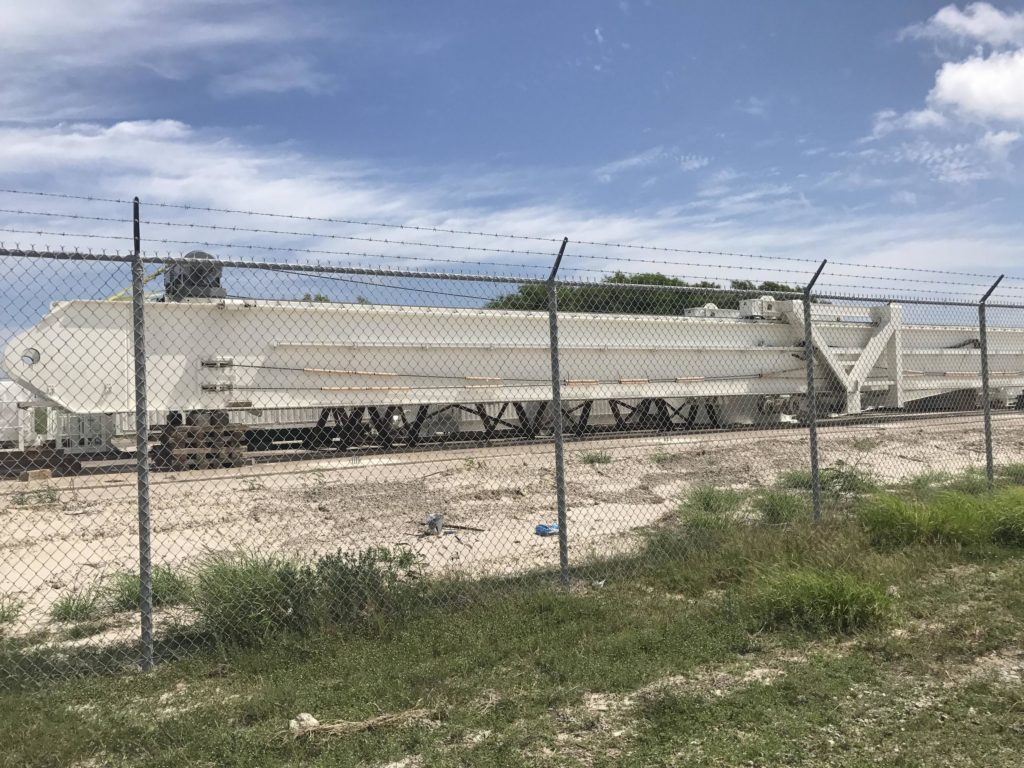
The boom of a giant crane (possibly meant for BFS) seen in late 2017, parked at SpaceX’s Boca Chica facilities. (Reddit /u/ ticklestuff)
While SpaceX’s communications policy reasonably avoids commenting on employee movement, the South Texas site’s late 2018 operational status would undeniably require a fair amount of work, likely on the order of the refurbishment and repair of the SLC-40 pad. This indirectly lends at least a sliver of credence to a recent claim from Space Florida, a state-run economic development agency focused on aerospace, that a portion of the workers involved in the refurbishment of LC-40 and LC-39A’s Falcon Heavy upgrades have begun “working on their Brownsville [TX] site.”
Dale Ketcham, Space Florida: people who worked on LC-39A and SLC-40 here for SpaceX now working on their Brownsville site. Georgia will be offering a spaceport site just as attractive to launch customers as Brownsville.
— Jeff Foust (@jeff_foust) March 1, 2018
Indeed, local South Texas fans of SpaceX have done an outstanding job of tracking the progress made at the Boca Chica launch facility over the last several years, and activity at the site does appear to have exploded in recent months, relative to the several years of quiet landscaping that followed its 2014 announcement.
Most recently, the addition of a solar array installation, Tesla Powerpacks, and an 800-kilowatt generator gives the construction zone the ability to generate considerably more than 1MW of grid-independent power, likely more than enough to operate both a bevy of construction equipment and SpaceX’s Crew Dragon communications complex.

Solar installation at SpaceX’s facility in Boca Chica, Texas [Credit: Nomadd via NASASpaceFlight.com Forum]
Ultimately, it’s all but guaranteed that significant increases in construction and development activity (or the lack thereof) will be immediately noted and communicated by observant locals. If SpaceX hopes to make its South Texas site operational before the end of the year, major work can be expected to begin within a handful of months at most. In the meantime, activities in Los Angeles, CA, particularly the Port of San Pedro, will offer another source of data on BFS’ development progress. Now we wait…
Get real-time updates from our Space Team and follow:
- Teslarati – Instagram (live stories) – Twitter
- Tom Cross – Twitter
- Pauline Acalin – Twitter
- Eric Ralph – Twitter

Elon Musk
Elon Musk’s X will start using a Tesla-like software update strategy
The initiative seems designed to accelerate updates to the social media platform, while maintaining maximum transparency.

Elon Musk’s social media platform X will adopt a Tesla-esque approach to software updates for its algorithm.
The initiative seems designed to accelerate updates to the social media platform, while maintaining maximum transparency.
X’s updates to its updates
As per Musk in a post on X, the social media company will be making a new algorithm to determine what organic and advertising posts are recommended to users. These updates would then be repeated every four weeks.
“We will make the new 𝕏 algorithm, including all code used to determine what organic and advertising posts are recommended to users, open source in 7 days. This will be repeated every 4 weeks, with comprehensive developer notes, to help you understand what changed,” Musk wrote in his post.
The initiative somewhat mirrors Tesla’s over-the-air update model, where vehicle software is regularly refined and pushed to users with detailed release notes. This should allow users to better understand the details of X’s every update and foster a healthy feedback loop for the social media platform.
xAI and X
X, formerly Twitter, has been acquired by Elon Musk’s artificial intelligence startup, xAI last year. Since then, xAI has seen a rapid rise in valuation. Following the company’s the company’s upsized $20 billion Series E funding round, estimates now suggest that xAI is worth tens about $230 to $235 billion. That’s several times larger than Tesla when Elon Musk received his controversial 2018 CEO Performance Award.
As per xAI, the Series E funding round attracted a diverse group of investors, including Valor Equity Partners, Stepstone Group, Fidelity Management & Research Company, Qatar Investment Authority, MGX, and Baron Capital Group, among others. Strategic partners NVIDIA and Cisco Investments also continued support for building the world’s largest GPU clusters.
News
Tesla FSD Supervised wins MotorTrend’s Best Driver Assistance Award
The decision marks a notable reversal for the publication from prior years, with judges citing major real-world improvements that pushed Tesla’s latest FSD software ahead of every competing ADAS system.

Tesla’s Full Self-Driving (Supervised) system has been named the best driver-assistance technology on the market, earning top honors at the 2026 MotorTrend Best Tech Awards.
The decision marks a notable reversal for the publication from prior years, with judges citing major real-world improvements that pushed Tesla’s latest FSD software ahead of every competing ADAS system. And it wasn’t even close.
MotorTrend reverses course
MotorTrend awarded Tesla FSD (Supervised) its 2026 Best Tech Driver Assistance title after extensive testing of the latest v14 software. The publication acknowledged that it had previously criticized earlier versions of FSD for erratic behavior and near-miss incidents, ultimately favoring rivals such as GM’s Super Cruise in earlier evaluations.
According to MotorTrend, the newest iteration of FSD resolved many of those shortcomings. Testers said v14 showed far smoother behavior in complex urban scenarios, including unprotected left turns, traffic circles, emergency vehicles, and dense city streets. While the system still requires constant driver supervision, judges concluded that no other advanced driver-assistance system currently matches its breadth of capability.
Unlike rival systems that rely on combinations of cameras, radar, lidar, and mapped highways, Tesla’s FSD operates using a camera-only approach and is capable of driving on city streets, rural roads, and freeways. MotorTrend stated that pure utility, the ability to handle nearly all road types, ultimately separated FSD from competitors like Ford BlueCruise, GM Super Cruise, and BMW’s Highway Assistant.
High cost and high capability
MotorTrend also addressed FSD’s pricing, which remains significantly higher than rival systems. Tesla currently charges $8,000 for a one-time purchase or $99 per month for a subscription, compared with far lower upfront and subscription costs from other automakers. The publication noted that the premium is justified given FSD’s unmatched scope and continuous software evolution.
Safety remained a central focus of the evaluation. While testers reported collision-free operation over thousands of miles, they noted ongoing concerns around FSD’s configurable driving modes, including options that allow aggressive driving and speeds beyond posted limits. MotorTrend emphasized that, like all Level 2 systems, FSD still depends on a fully attentive human driver at all times.
Despite those caveats, the publication concluded that Tesla’s rapid software progress fundamentally reshaped the competitive landscape. For drivers seeking the most capable hands-on driver-assistance system available today, MotorTrend concluded Tesla FSD (Supervised) now stands alone at the top.
News
Elon Musk’s Grokipedia surges to 5.6M articles, almost 79% of English Wikipedia
The explosive growth marks a major milestone for the AI-powered online encyclopedia, which was launched by Elon Musk’s xAI just months ago.

Elon Musk’s Grokipedia has grown to an impressive 5,615,201 articles as of today, closing in on 79% of the English Wikipedia’s current total of 7,119,376 articles.
The explosive growth marks a major milestone for the AI-powered online encyclopedia, which was launched by Elon Musk’s xAI just months ago. Needless to say, it would only be a matter of time before Grokipedia exceeds English Wikipedia in sheer volume.
Grokipedia’s rapid growth
xAI’s vision for Grokipedia emphasizes neutrality, while Grok’s reasoning capabilities allow for fast drafting and fact-checking. When Elon Musk announced the initiative in late September 2025, he noted that Grokipedia would be an improvement to Wikipedia because it would be designed to avoid bias.
At the time, Musk noted that Grokipedia “is a necessary step towards the xAI goal of understanding the Universe.”
Grokipedia was launched in late October, and while xAI was careful to list it only as Version 0.1 at the time, the online encyclopedia immediately earned praise. Wikipedia co-founder Larry Sanger highlighted the project’s innovative approach, noting how it leverages AI to fill knowledge gaps and enable rapid updates. Netizens also observed how Grokipedia tends to present articles in a more objective manner compared to Wikipedia, which is edited by humans.
Elon Musk’s ambitious plans
With 5,615,201 total articles, Grokipedia has now grown to almost 79% of English Wikipedia’s article base. This is incredibly quick, though Grokipedia remains text-only for now. xAI, for its part, has now updated the online encyclopedia’s iteration to v0.2.
Elon Musk has shared bold ideas for Grokipedia, including sending a record of the entire knowledge base to space as part of xAI’s mission to preserve and expand human understanding. At some point, Musk stated that Grokipedia will be renamed to Encyclopedia Galactica, and it will be sent to the cosmos.
“When Grokipedia is good enough (long way to go), we will change the name to Encyclopedia Galactica. It will be an open source distillation of all knowledge, including audio, images and video. Join xAI to help build the sci-fi version of the Library of Alexandria!” Musk wrote, adding in a later post that “Copies will be etched in stone and sent to the Moon, Mars and beyond. This time, it will not be lost.”
